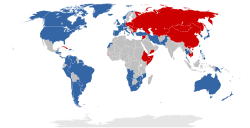
Back العالم الثاني Arabic Segon Món Catalan Druhý svět Czech Den anden verden Danish Dua mondo Esperanto Segundo mundo Spanish Teine Maailm Estonian Bigarren Mundua Basque جهان دوم Persian Toinen maailma Finnish

The Second World is one of the "Three Worlds" formed by the global political landscape of the Cold War, as it grouped together those countries that were aligned with the Eastern Bloc of the Soviet Union. This grouping was directly opposed to the First World, which similarly grouped together those countries that were aligned with the Western Bloc of the United States. It included communist states that were originally under the Soviet sphere of influence, though some eventually broke away from the Soviet ideology (e.g., Yugoslavia's split and China's split) to develop their own path as socialist states while retaining their communist governments. Most communist states remained under Soviet influence until the Revolutions of 1989. In 1991, upon the dissolution of the Soviet Union, only five communist states remained: China, Cuba, Laos, North Korea, and Vietnam. Though the terms "First World" and "Third World" continue to see present-day relevance in colloquial speech, albeit with a repurposed definition, the term "Second World" is obsolete outside of a Cold War context.
© MMXXIII Rich X Search. We shall prevail. All rights reserved. Rich X Search